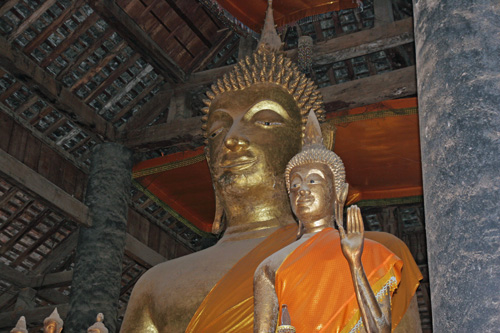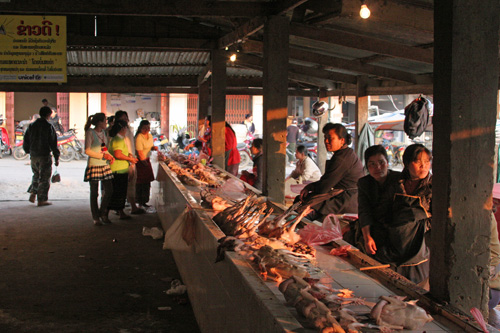The whole city of Luang Prabang is listed as a World Heritage cultural site. It does not take long in the city to understand why. Out first full day there started very early, even before sunrise. Yet once we arrived on the main street Th Sisavangvong, there is already a lot of activity. Before sunrise, monks from the local monasteries parade through town begging for food and it has become a custom for tourists as well as locals to participate in this ritual.
Enterprising shop owner set up stalls where one can purchase the rice that will be donated to the monks.
This area is set up for a large tour group of Thai tourists. The tourists arrive at the last minute – I am glad we are here early as the preparations are just as fascinating as the event itself.
Monks from each monastery arrive in single file as the light of day is slowly increasing.
What a better picture that a row of monks in bright orange robes in front of some of the local architecture which are the fame of the city.
After a short stay in the area where a lot of tourists come, we moved to another areawhere generally only locals come. The monks loop around and pass through here on their way back to the monasteries. People have set up their own ‘donation’ area along the other main street inthe center of town, Bat Wat Nong. The whole family (three generations of it) is involved in this daily event.
Once they have received enough food, the monks do not accept any more donations. Actually, they become donors themselves. I whitnessed a scene which only became clear to me after it happened and therefore I was not able to capture it. There are people along this street who are here to donate to the monks; but there are also people here hoping to benefit from their generosity. I saw one young lady who was kowtowing in front of a small bowl as the monks walked by. Occasionally, I would see a monk leaving some food in her bowl – she never looked up, they never broke stride. Unfortunately, before I realised what was happening, she must have received enough food and left.
Members of our group decided to participate as well, donating bread instead of rice – a little variety in one’s diet never hurts.
There are rules on how you should do this – everybody sits on a mat, either kneeling on it or sitting up on a chair. One also has to be bare footed to donate.
After this first experience, and still before breakfast, we went to the local street market. As always, it is a mixture of tourists and local people, mostly locals at this early hour, and a mixture of market and social gathering. I suspect that quite a few people come here to have their breakfast as a lot of food is actually being prepared in the different stalls.
Markets are colorful affairs
Ever seen chickens doing the Can-Can? Of course you have, on this blog a few months ago (see post called “Retrospective – Mardi Gras 2005” from January 2010) . Here is another rendition…
The charcoal grill is working overtime making chicken and fish on a stick.
Luang Prabang, for most of its history, was the seat of the local government and also the home of the king. It was here that the last king of Laos lived before he was deposed by the Pathet Lao, or communists in 1975. The royal Palace is now a museum of Lao history and culture.
Other than the tourist taking a picture with a digital camera, this scene could have been unchanged for many years
In the cellars of the palace, a Japanese NGO has set up a workshop to restore Buddha Statues. VIPs were visiting as I was there, making sure, I guess, that the very important statues are treated properly.
The park around the Royal Palace is fertile ground for photo opportunity. I saw this scene from quite a distance, and took several photos as I was getting closer and closer, not wanting to be noticed. I was not the only one on the hunt as another member of our group was also stalking just a few meters from me.
Our tour of Luang Prabang continued with a visit to the oldest temple in town, Wat Wisunarat, originally built in 1531. The stupa in front of the main hall is commonly referred to as the Watermelon, for obvious reasons
Inside the temple, there are, as always, numerous Buddha statues and a few others
Our visit took us next to the most magnificent (not my words) temple in Luang Prabang: Wat Xieng Thong, built in 1560 and remianed under royal patronage until 1975, when the last king was deposed. It does have magnificent (my word) buildings. This is the main temple.
While this building houses the funeral chariot used for the royal family
In the back of the main temple is a mosaic with the “Tree of Life” – one of the best I have seen, but hard to photograph as the light reflection completely changes the color.
The top of the tree trunck is exactly the same color as the bottom, but reflects the sky giving it a lighter shade.
On the side of the building is a decorated elephant head.
and the inside is again full of Buddha statues, one more magnificent that the other.
However beautiful are the temples and palaces of Luang Prabang, its real striking beauty is really the general architecture and the small streets and alleyways that form the city. Everywhere you turn there are peaceful corners and areas that are just begging to be explored.
Not Cherry blossoms, but the effect is very similar in this temple: Wat Nong Sikhunmeuang – please do not ask me to repeat this rapidly ten times.
Another view of the same temple (I told you I would not repeat its name…). In the background is Phu Si, a hill that is right in the middle of town. You are supposed to go to the top to watch the sunset – however, with all the smoke in the air, the view was completely obscured and the sun disappeared behind the smoke long before it disappeared behind the mountains in the distance.
We still climbed to the top, and on the way, had a good view of the Royal Palace, with the arts and crafts market setting up in the foreground.
On the way down, a different way that the way up, there are more Buddha statues
and a ‘hermit’s cave?’
Luang Prabang is at the confluence of the Mekhong and a smaller river called the Nam Khan. The level of the water is so low that they have had to improvise bridges across. This does not seem like it would survive during the wet season, but I did not see any bridge that looked like it would. Maybe they use ferries in the wet and re-built the bridges every dry season – disposable bamboo bridge, or a new tla (three letter acronym) – I will refer to them as DBB’s from now on…
But it was soon time to leave Luang Prabang and head North East towards Ponshavan, about 250 km or 5 hours away. This stall was right in front of the school – is she selling breakfast or lunch?
Just standing at a street’s corner, there are photo opportunities every minute. Mother and child going to school/work, the way everybody travels here
On the way to Ponshavan, we stopped in a small village, just to stretch our legs. The local petrol station is unusual, for us.
But it is usually the people I find most interesting. An old man making a broom …
Children heading home from school for lunch
Even younger children looking at the tourists looking at them
and well looked after, I am sure
People just going about their daily business
Ponshavan is at the center of an area that was heavily bombed during the Vietnam War – this was a hidden war, never declared and never admitted until there was no other choice. The northern Lao, especially the communist Pathet Lao, were supposed to support the North Vietnamese and between 1964 and the early 70’s more bombs and more tonnage of explosives were dropped in this area than on Germany during all of WWII. To this day, there are still 100’s of unexploded ordinances found in fields and forests every year.Before dinner, we stopped at the local market – permanent and covered this time. I will resist making any comments about chickens in this occasion.
We also went to visit the local offices of MAD, an NGO which is organising teams to clean the countryside of unexploded ordinances. It is a huge effort and they are going about it in a systematic way. It is them we can thank for being able to safely visit the sites of jars we will be seeing tomorrow. Here is a link to their web site if you want to learn more about them – they are doing this work all over the world!
http://www.maginternational.org/
The area around Ponshavan is mainly known for giant limestone jars that were left here more than 2000 years ago by a people that totally disappeared and we know little about. The real purpose of these jars is still not known, even though there are as many theories as there are archeologists and anthropologists studying the matter.
I did say the truth when I said ‘giant’ jars – these are not the kind that you carry on top of your head going to the local market!
They seem to be randomly thrown about the landscape with over 300 jars at this site alone.
Our last stop is at the site of the “Lucky Buddha” – positive thinking. A lot of people would have called this an unlucky Buddha as the temple housing it was completely destroyes. However, the statue was left essentially intact – hence “Lucky”
It is off to Vientiane next – the Capital of Laos. That will be the subject of the third installment of this trip.
(1931 Page Views)















































Hi Pierre,
Its great reliving the trip again through your eyes and words. Hope you are keeping well, rgds Marc & Lorna,South Africa.
@pierreo.com The parade of monks is an interesting sight. I also like the pictures of the back streets.